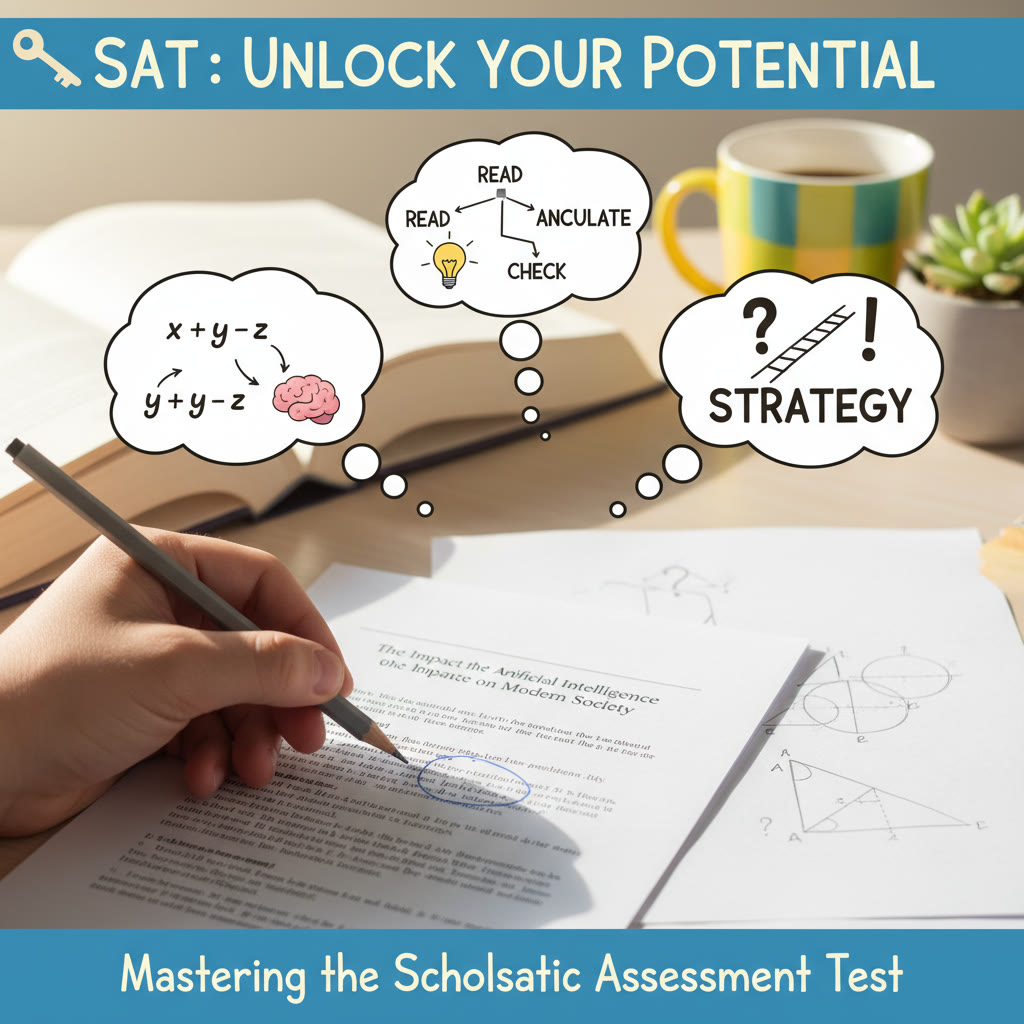Imagine the Score You Want: Why Visualization Belongs in Your SAT Toolkit
Close your eyes for a moment and picture walking into the SAT testing room: the cool hum of the air, the quiet rustle of other students, your pencil moving smoothly as you solve the next math problem. You feel calm, confident, and clear-headed. That mental image—created on purpose—is more than wishful thinking. It is a practice technique used by elite athletes, musicians, and successful test-takers to build skills, reduce anxiety, and prime the brain for high performance.
This post gives you a practical, research-informed roadmap for using visualization to imagine SAT success. You’ll find simple scripts, daily exercises, a sample 4-week plan, and realistic ways to weave mental rehearsal into your study time so visualization becomes a reliable part of how you prepare. Where it makes sense, I’ll point out how Sparkl’s personalized tutoring and tools can amplify these benefits with tailored guidance, 1-on-1 coaching, and AI-driven insights.
What Visualization Actually Does for the Brain
Mental rehearsal is practice, too
When you visualize doing an activity—say solving a math problem or pacing through a reading passage—you activate many of the same neural circuits that fire during the physical act. That overlap means the brain treats detailed mental practice as complementary to physical practice. For SAT prep, visualization helps with:
- Reducing anxiety by making the test environment familiar.
- Sharpening timing and pacing decisions before you’re under the clock.
- Reinforcing effective problem-solving sequences so they feel automatic.
- Strengthening focus and attention during noisy or distracting circumstances.
Visualization vs. Rote repetition
Rote repetition builds memory; visualization builds procedural fluency and mental context. Instead of only repeating practice problems, visualize the steps you’ll take when you see a new passage or a tricky math question—preview, plan, solve, check. That mental map reduces the cognitive load during the actual test because parts of the process feel familiar and practiced.
How to Visualize Effectively for the SAT: Principles That Work
1) Make it vivid and sensory
Details matter. A fuzzy, general thought—”I’ll do well”—does little. A crisp image that includes sights, sounds, feelings, and actions makes the brain’s rehearsal stronger. Visualize the look of the test booklet, the movement of your pencil, the relief when you bubble the correct answer. Add sensory cues: the faint paper smell, the tapping of a clock, the steady rhythm of your breathing.
2) Include the entire process, not just outcomes
Don’t only picture a high score. Visualize the process that produces that score: how you read a dense passage, how you underline the main idea, when you decide to skip a hard question and come back, how you manage time during each section. Process-focused visualization trains decision-making under realistic conditions.
3) Pair mental rehearsal with real practice
Visualization alone is helpful; combined with deliberate practice it’s powerful. Spend part of your session physically working through problems and part of it mentally rehearsing strategies. For example: after finishing a set of timed reading sections, close your eyes and replay how you navigated the hardest paragraph.
4) Use short, frequent sessions
Five to ten minutes a day of focused visualization beats a single long session. The brain consolidates repeated brief rehearsals more effectively, and short sessions fit easily into busy schedules. During the week before the SAT, increase the frequency but keep sessions calm and confident rather than frantic.
Concrete Visualization Exercises You Can Start Today
Exercise A — 5-minute “Test-Entry” Routine
- Sit comfortably, breathe slowly for 30 seconds.
- Picture entering the test center: the line, the proctor’s quiet directions, your seat. See yourself sitting, opening the booklet, and reading the first question calmly.
- Visualize a specific action you’ll take on question one (e.g., annotate the passage, draw a quick diagram, or eliminate two answer choices).
- End with a confident breath and the phrase: “I will do this step-by-step.”
Exercise B — 10-minute Section-Specific Script (Math)
Use this after you’ve studied a particular math topic (algebra, functions, geometry):
- Close your eyes and see a math problem of that type on the page.
- Frame the initial question: what information is given, what’s asked?
- Mentally run through the solution: set up equations, choose a strategy (work backwards, plug in numbers, draw a diagram), and carry out the steps with clear visual markers (a circled variable, a neat diagram in the margin).
- Conclude by visualizing checking your work and marking the bubble confidently.
Exercise C — 8-minute Reading Focus Drill
- Imagine the first paragraph of a complex passage. Picture the main idea forming like a headline in your mind.
- Visualize a quick margin note that captures the author’s tone: skeptical, admiring, neutral.
- See yourself finding the line reference for a specific detail and scanning there quickly, like moving a magnifying glass over the text.
Sample Visualization Script: The Calm Countdown (10 minutes)
This guided script is perfect for the morning of the test or the night before as a final mental run-through.
- Minute 0–1: Sit comfortably and breathe. Name three small things in the room silently.
- Minute 1–3: Picture arriving at the test center, handing in your phone, finding your seat. Notice how your breathing stays steady.
- Minute 3–5: See the first section start. Visualize reading the first question clearly, underlining key words, and deciding on the quickest strategy.
- Minute 5–7: Imagine encountering a hard question. Visualize skipping it without panic, marking it to return to, and moving on confidently.
- Minute 7–9: Picture the last ten minutes of a section—checking pacing, bubbling answers, and staying composed.
- Minute 9–10: Close with one slow breath and the phrase: “I am prepared, calm, and focused.”
When to Use Visualization During Your Prep Cycle
Integration beats isolation. Here’s how to weave visualization into a normal study week without losing the necessary physical practice time.
- Before practice: A 1–2 minute mental preview primes your focus for the topic you’re about to study.
- After practice: A 5-minute replay consolidates what you learned and highlights improvements or mistakes.
- Before timed sections: A quick 30–60 second calming image anchors your pace and reduces initial anxiety.
- Night before the test: A longer 8–12 minute script helps lock in calm readiness.
Sample 4-Week Visualization + Practice Plan
This table shows a balanced approach that pairs physical practice with structured visualization. Adjust intensity and topics to match your weak areas.
| Week | Visualization Focus | Practice Tasks | Daily Time (visualization + practice) |
|---|---|---|---|
| Week 1 | Test-entry routine, calm countdown, section pacing | Diagnostic test; identify weakest section; targeted practice sets | 40–60 minutes |
| Week 2 | Problem-step visualizations (math), passage mapping (reading) | Timed section practice; review mistakes; strategy drills | 50–70 minutes |
| Week 3 | Time-management scenarios, skipping and return strategies | Full timed sections; targeted drills on pacing | 60–90 minutes |
| Week 4 | Test-day simulations, confident finish, error-check visuals | Full-length mock test; review and light practice; rest days | 60–120 minutes (including mock test) |
How to Measure If Visualization Is Working
Key indicators to track
- Improved consistency on timed sections (fewer big swings in scores).
- Faster reductions in stress during practice tests (self-rated anxiety levels).
- Better pacing decisions—fewer rushed last-minute answers or unfinished sections.
- Subjective sense of control during hard problems: you feel like you know your plan.
Record these metrics in a simple study journal and look for trends over 2–3 weeks. Mental techniques often show gradual improvements rather than overnight transformations.
Common Pitfalls and How to Avoid Them
Pitfall: Vague, wishy-washy images
Fix: Use sensory detail and process-focused imagery. Replace “I will do well” with “I will read the first paragraph, underline the thesis, and summarize it in the margin.”
Pitfall: Using visualization instead of practice
Fix: Pair visualization with measurable practice tasks. Think of mental rehearsal as magnifying the value of your practice, not replacing it.
Pitfall: Overconfidence without feedback
Fix: Keep objective checks—timed sections, score tracking, and external feedback. If you’re working with a tutor or coach (for example, Sparkl’s expert tutors), use their input to calibrate your mental scripts for realism.
Real-World Examples: How Students Use Visualization
Case 1: Maya, improving pacing. Maya consistently ran out of time in the reading section. She started a 3-minute visualization where she pictured herself scanning paragraphs with a “map” in her head and skipping two particularly dense questions to return later. After two weeks of pairing the visualization with timed sections, her unfinished-question rate dropped by half.
Case 2: Jonah, calming test-day nerves. Jonah’s scores were fine in practice but he froze on test day. His coach taught him a short breathing-and-visualization routine: close eyes, imagine the proctor’s calm voice, see completing the first two problems easily, and breathe. Doing this before each section made his heart-rate and errors drop significantly on the mock tests leading up to his test.
These are real, practical outcomes that come from combining mental rehearsal with deliberate practice. If you want, a Sparkl tutor can create personalized visualization scripts like these based on your exact test patterns and anxiety triggers—they offer 1-on-1 guidance and AI-driven insights that help tailor scripts and check progress.
Quick Scripts You Can Memorize
Two-minute pre-section calming script
“Breathe in for four, out for six. See the first question. Read it slow. Circle the key words. I know how to do this. If something’s hard, I’ll mark it and move on. I will be calm and clear.”
One-minute confidence booster
“I have prepared. I will work step-by-step. I can return to tough questions. I will finish this section with steady effort.”
Where Personalized Help Can Make Visualization Faster and More Effective
General scripts are a great starting point, but tailored visualization works best because it mirrors your unique strengths, weaknesses, and anxiety patterns. That’s where personalized tutoring shines. A tutor can:
- Design scripts that replay common mistakes you make and reframe them into effective actions.
- Use 1-on-1 sessions to practice live, giving feedback on whether your mental images are specific enough.
- Combine human expertise with AI-driven insights to spot patterns in your practice tests and create visualization drills targeting the exact moments where you lose points.
Partnering with a coach—like those at Sparkl—can speed up this refinement process so your visualization becomes a precise tool rather than a vague habit.
Putting It All Together: A Practical Day-of-Test Routine
Here’s a compact routine that combines visualization and practical steps the morning of the SAT:
- Wake with a short stretch and a glass of water.
- 10–12 minutes: run the Calm Countdown script (see above).
- Pack materials and eat a balanced breakfast; while doing so, run the Two-minute pre-section calming script in your head as you walk into the testing room.
- During short breaks between sections, close your eyes for 30–60 seconds, breathe, and visualize the first steps of the next section—focus on strategy not score.
- Finish each section by breathing slowly and moving on decisively to the next task.
Wrap-Up: Make Mental Rehearsal Work For You
Visualization isn’t magic. It’s a reliable, low-cost tool that strengthens the mental habits you need on test day: calmness, efficient problem-solving, intelligent pacing, and confident decision-making. When paired with disciplined practice and honest feedback, mental rehearsal helps close the gap between what you can do in quiet study and what you’ll do under pressure.
If you’re curious about making visualization more precise and personal, consider adding a tutor who understands both the SAT and mental-skills training. Sparkl’s personalized tutoring offers 1-on-1 guidance, tailored study plans, and AI-driven insights that can help you build visualization scripts tied directly to your practice data. That combination—mental rehearsal plus targeted coaching—can be the difference between hoping for a high score and reliably producing one.
Suggested Images


Final Thought
Visualization is a practice you build—like forming a good essay habit or learning to diagram equations. Start small, be consistent, pair it with real practice, and tweak based on objective feedback. Over time, the image of success becomes less imagination and more a mental routine you can rely on when it matters most.
Good luck. Breathe, visualize, practice, and trust the work you’ve put in. You’re not just hoping for a better SAT score—you’re rehearsing it into being.










No Comments
Leave a comment Cancel